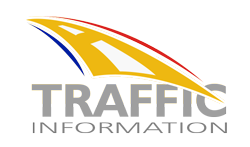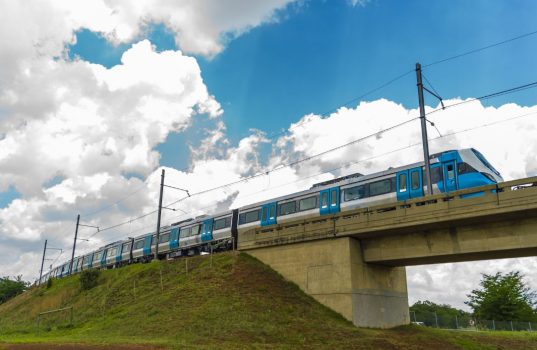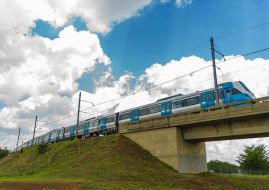Successful 10th edition of the UIC World Congress on High Speed Rail in Ankara
The UIC World Congress on High Speed rail, organised by UIC and TCDD, Turkish State Railways, for its 10th edition in Ankara from 8 to 11 May, brought together 1,000 participants from the rail and transport world, representing 30 countries. High level representatives, speakers and participants exchanged this year on ‘Sharing knowledge for Sustainable and Competitive Operations’.
Over the course of three days, all the actors concerned by the development of the high speed rail system held fruitful discussions on this theme. An opening session with official interventions (cf eNews n° 598), included the Turkish Minister of Transport Mr Ahmet Arslan and the President of the Board, Director General of TCDD and Vice Chairman of UIC Mr Isa Apaydin.
During the opening session, UIC Chairman, Mr Renato Mazzoncini, particularly highlighted the sustainable dimension of high speed: “High speed rail does have a part to play in responding to the challenge of reducing the sustainable impact of transport. In this sense the main High Speed Rail strategy is “shift to rail” where journey are made by lower CO2 per passenger emitting modes. High Speed Rail advantages in terms of energy consumption compared with other competitors is one of the main drivers to reduce carbon footprint in transport sector. A study conducted by UIC in France and China already concluded that the carbon footprint of High Speed Rail can be up to 14 times less carbon intensive than car travel and up to 15 times less than aviation even when measured over the full-life cycle of planning, construction and operation. The constant UIC cooperation with the United Nations are giving us the opportunities to better influence the UN Agenda. Also in terms of green finance, let me underline the crucial role green bonds could play in boosting growth by financing climate and environment goals. Promoting long-term green finance has to be one of our priorities to raise capital market finance. Today, we represent a decisive sector among transport modes. Each of our projects are directly impacting present and people’s lives in future, that is why I think we have to consider green bonds as instruments to mobilise capital. Green finance has the great potential to let investors make informed and explicit decisions.”
He followed by saying: “This UIC Congress, with its worldwide dimension, represents today an emblematic stage of the globalising world that the railway system is facing. The global high speed rail network is one of the great feats of modern engineering proving to be the best form of transportation ever invented. It is rapidly expanding across continents worldwide. Indeed High Speed Rail is currently in operation in more than 14 countries with a length of 42,000 Km.
The High Speed rail network is constantly growing and this proves why each year more than 2.2 million people decide to take High Speed Trains.
Over the past 10 years, High Speed has represented a complete transformation, a sort of revolution in motion. It not only boosted tourism, economic development and business but it also changed people’s lifestyles. For example, today travelling from Tokyo to Osaka, from Paris to Bordeaux, from Madrid to Barcelona, from Rome to Milan, from Saint Petersburg to Moscow, from Seoul to Busan and from Beijing to Shanghai by High Speed train has become a daily fact.
Indeed, from 2010 to 2016 the number of passenger/km increased from 248 to 715 billion, more than 460 billion only in China. Once again allow me to underline how the service and quality we delivered in the past 10-12 years have been well recognised by users and rail passengers.”
Finally, he highlighted the projects, investments and benefits of the high speed system of tomorrow.
He said: “Most of the countries allocated significant investments to High Speed Rail. Money spent today in High Speed is going to go a long way into the future.
16 countries currently have 14,000 km of High Speed network (8000 miles) under construction, while 36 countries have 35,000 km (22 000 miles) of planned lines. Ambitious projects for high speed links are being developed in several countries aiming at achieving economic, social and territorial cohesion in boosting economic growth and development while ensuring more connectivity. The European Union has been pursuing Trans European Transport Corridors for almost 20 years and still plan to invest 500 billion euros; China has developed in the last 15 years an impressive high speed rail system with huge investments; the USA is also predisposed to make extensive investments; India is on the verge of a new rail deal. All major world economies are developing new corridors comprising rail high speed such as the Miami Orlando brightline, the Mumbai- Ahmedabad, the Kuala Lumpur – Singapore, the Moscow-Kazan and the Casablanca-Rabat-Tangier. All these projects are creating thousands of jobs either during construction, or operation and maintenance. Now, new forms of transport are emerging, thanks to the technological revolution. In this context, everyone is waiting for the completion of the Maglev line between Tokyo and Osaka as well as what Hyperloop can bring. These new technologies will be rated according to their cost-benefits and in terms of capacity, availability, frequency, affordability and sustainability.”
And he concluded by saying: “Today, at this Congress we have the opportunity again to strengthen UIC’s mission and values in promoting High Speed Rail transport at world level. I hope that each debate and idea that emerges from the next parallel sessions and round tables will lead us to strengthen and create new technical and environmental performances, to improve competitiveness and to reduce costs.”
UIC Director General, Mr Jean-Pierre Loubinoux, said: “More than 3000 high speed trainsets are operating daily worldwide transporting 2.2 billion customers every year. High speed, wherever it has been developed, is a booster of innovation for the railway sector and its industry. Why not imagine it would be the new opportunity to be the vector of a new freight high speed mobility in line with e-commerce, development. High speed, wherever it has been developed, is an enabler of employment and growth of GDP. High speed, wherever it has been developed or will be developed, must be accompanied in parallel by the renovation or upgrade of conventional interconnected lines, to extend the benefit of speed to larger and further territories and cities”.
He followed by saying: “High speed helped railways to survive the third energy and technical revolution. As a driver for the rail sector, it must now be an actor and vector of this fourth industrial revolution of the 21st century, the digital revolution. New connectivity, big data, blockchain, augmented intelligence, will bring to the rail sector better productivity, in operation and maintenance, better security (cybersecurity) and better services for its customer experience”.
He added: “UIC, as the worldwide association of railways, with research institutes and its network of universities, always wish to bring innovative ideas, successful experience, breakthrough developments to its members, to the railway sector”.
Mr Marc Guigon, Director of the UIC Passenger Department, presented the status of High Speed Rail around the world, describing the evolution from the last Congress of Tokyo to the current Congress. He indicated the increase of High-Speed network was 20 % in three years to reach 42,000 km during the Congress, and 46,000 km for the end of this year. The increase of passenger km was more than 40 % over the last three years; that means the existing network increases its efficiency by 20 %. Then he showed maps of High-Speed lines under construction and planned in all continents. He finished with the evolution of rolling stock and railway stations.
Mr Philippe Citroen, Director General of Unife, presented the industry view. He explained that signalling increases capacity and said: “The European rail supply industry strongly contributes to high speed markets through major flagship projects around the world”.
Three round tables were also organised on subjects such as “New Competition and cooperation: what is the impact on High Speed Rail business?”, “How can High Speed Rail (re)shape local and regional development?” (round table moderated by Ambassador Michael B. Christides, General Secretary of Black Sea Economic Cooperation BSEC together with Professor Andrew McNaughton, Strategic Technical Advisor of HS2 Ltd), “Sustainability of High Speed Rail system: experiences and perspectives” (moderated by Mr Isa Apaydin, President of the Board, Director General of TCDD and Vice Chairman of UIC).
During the first one, on New competition and cooperation, Mr Mohamed Mezghani, Secretary General of UITP, who co-moderated the session together with Mr Michel Leboeuf, Honorary Chairman of UIC High speed Rail Committee, said: “Intermodality is the key word. New technologies should be more included into a door to door package”.
During this three-day congress, 25 parallel sessions took also place and gave the floor to 115 speakers which grouped together more or less one hundred people. Subjects addressed among others infrastructure planning, infrastructure earthworks, infrastructure bridges & viaducts, rail system signalling, station design & architecture & performance, train design and purchasing strategy, commercial competition & traffic forecasts, electric power supply, operation maintenance, socio-economy service quality, RAMS and cybersecurity (session moderated by UIC Head of Security Division Jacques Colliard, who emphasised the importance of managing carefully the huge amount of data), energy and environment (session moderated by UIC Director of Fundamental Values Jerzy Wisniewski, who emphasised that UIC Members work together to make railway the backbone of sustainable transport and to develop rail transport to meet the needs of sustainable mobility), as well as Asset Management & LCC, maintenance renewal, standards & regulations, station construction & management & connections (session moderated by the Director of the UIC Passenger Department Marc Guigon), or territory management.
During the closing session held on 10 May, a session was dedicated to universities and the crucial role that they can play in the railway dynamism. Professor M. NING Bin, Academic of China Engineering Academy and President of University of Transport of Beijing (BJTU), presented the main objectives of the Universities Alliance network. Among them: the need to identify the specific research projects with common interest, or the need to establish several joint graduate-students education programs.
He also made a call to Universities wishing to join this club. He said: “UIC is a driving force for sharing the railway knowledge”.
Another session was dedicated to the necessary link that railways have to develop with the start-up ecosystem if they want to remain open to the latest developments and innovations.
Three start-ups presented their projects in front of the audience of the Congress, and the public voted for their favourite one. The first was Ermeo Company, which provides a business software solution to convert technical documentation into an interactive and smart format; the second one was SocialDev, which provides virtual interactive train operator or how to improve the traveller experience. The third one was Hedgehog solutions, which provides energy saving solutions.
Three students from Turkish Universities also had the possibility to present their innovative projects in favour of high speed rail.
The closing session also gave the opportunity to key speakers to take the floor. Mr Donald Upson, Co-founder and Vice Chair of CES Government, Upson Technology Group, addressed the participants with inspiring thoughts on the development of technology. Mr François Davenne, Secretary General of Intergovernmental Organisation for International Carriage by rail (OTIF), presented the work done by his organisation and said: “We have to work together to make this global network happen. OTIF provides interoperability beyond EU. And access to network is a priority”.
During this Congress, the host country, our co-organiser and UIC Member from the Middle East region TCDD (Turkish States Railways), had the pleasure to organise several technical visits in order to present to the participants the real vitality of Turkish railways, through the visit of several railway places, such as the visit of Ankara Railway Station, a visit of a rolling stock maintenance centre and a visit of the city of Konya, organised by taking the high-speed train from Ankara, and a ride in the driving cab at 250 km/h.
A trade exhibition was held to demonstrate the products, the solutions, the innovations offered by the industry. 51 exhibitors participated in the trade exhibition in several booths: China (CARS, CR, CRCC, CRDC, CREC, CRRC, CRSC),TCDD, Spain (Renfe, ADIF , CAF, Talgo), FS, Siemens, RTRI…
Finally, Jean-Pierre Loubinoux delivered a few concluding words: “Our UIC values, to open, to share and to connect have been very well respected here. A lot of information was exchanged, many messages were given, and a vision was shared”.
He followed by saying: “Rail is not just a mode of transportation but also a means of social and economic growth. And possibly a vector of peace in international links, in once again bridging continents with trains”. And then: “During three days in Ankara, information on technology, services, customer experience and expectations, and new projects was exchanged”.
He finished by saying: “Over three days in Ankara, messages on the position of high speed as a backbone of a new chain of sustainable, integrated, connected, international mobility were given. Chain in which transportation is becoming a combination of spare and time slots”.
Jean-Pierre Loubinoux also briefly presented a book in preparation at UIC on High speed rail, in cooperation with Langages du Sud. The subject of the book is: “An invitation to travel. High speed rail lines around the world”. The publication will be launched in autumn 2018 in French and English.
The next two editions of the UIC World Congresses on High speed rail were announced by Jean-Pierre Loubinoux, UIC Director General, during the closing ceremony on 10 May. The 11th Congress will be held in China at the end of 2019 or 2020. The place and date are currently in discussion with China Railways CR. The theme would be “Augmented Intelligence for Mobility” and would expand to more topics than the high speed issue, in line with the creation of the UIC Passenger Forum, and of course in relation with the UIC digital team. Morocco will host the 12th edition in 2021.
To finish, it is worth mentioning the further high speed meetings to be held in 2018: the Intercity and High speed plenary committee meeting will be held in Berlin on 17 September, and the UIC training on high speed systems will take place in Madrid from 10 to 14 December.
The presentations of the 10th UIC World Congress on High Speed Rail will be available soon for speakers and participants.
The UIC team warmly Turkish State Railways TCDD for their hospitality, their involvement and their friendship. UIC also thanks CMS Project for their support and cooperation.
Road Safety and Rail Crossings/ Level Crossings – Know how to approach and cross safely! https://t.co/DrbxOCwzS1 #ArriveAlive #levelcrossings @PRASA_Group @Rail_Safety pic.twitter.com/mPrElJ2z9j
— Arrive Alive (@_ArriveAlive) February 20, 2018
Related Posts
« What are the benefits of travel on Tolled Roads? 10th edition of (International Level Crossing Awareness Day) ILCAD June 7, 2018 Launch conference, Zagreb, Croatia. »





























